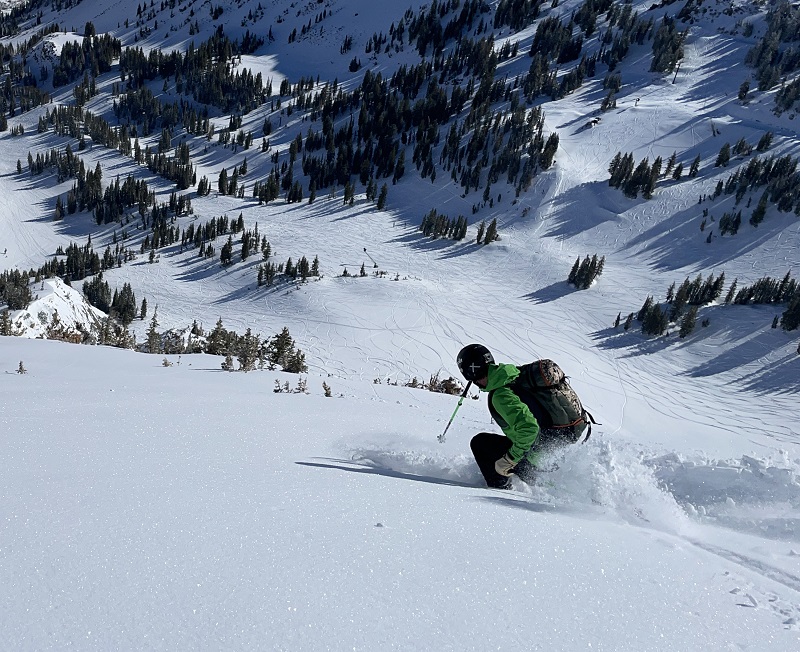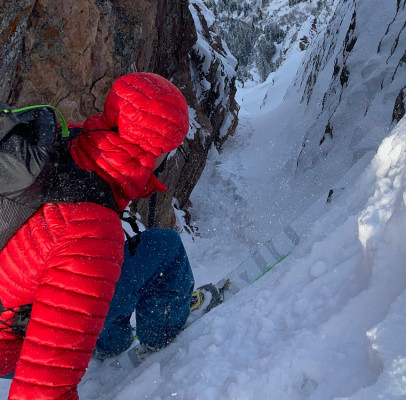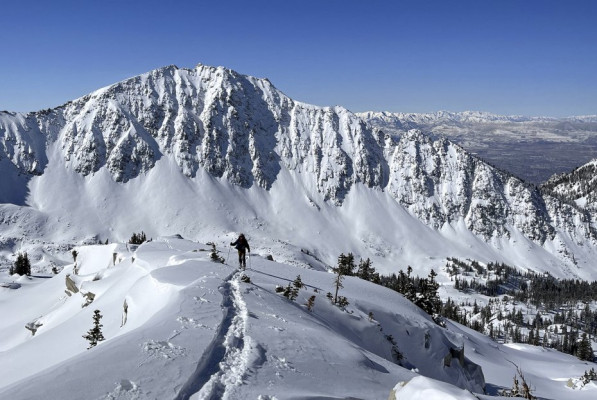9/26/2022 90mm Free-touring Skis
We’re not sure if the ski industry is responding to basic market signals or if it’s run by a shadowy cabal that dictates what the cool kids will be skiing for the next couple of seasons. Either way, a new backcountry ski category seems to be taking shape for the 2022-23 season. We call it the “90mm Freetour” trend. AKA skinny waist, big personality.
At this width, the skis are obviously much leaner than most freeride skis, but are nonetheless designed with similar downhill performance in mind as their fatter brethren. The manufacturers often borrow the same core construction, shape, and profile from their existing freeride skis (you know, the genre that is traditionally associated with skis 100mm and up).

Skimo Co Note: Please note that when we use the term "freeride", we aren't referring to the type of skiing that has "World Tours" where you're encouraged to flip, spin, and otherwise launch yourself down the mountain in order to gain points. In the backcountry where ski patrol is not waiting to clean up bodies, the term "freeriding" describes a free-flowing aggressive style, but one where you always ski in control. In Europe, this is becoming known as "free-touring" or "freetouring", which we will use interchangeably here.
While 90-waisted free-touring skis are not totally unheard of (looking at you, ahead-of-the-curve Movement Alp Tracks 90), this somewhat counterintuitive blend of freeride style near the 90mm mark seems to be a growing genre in the backcountry. One bet is that customers have come to appreciate the climbing efficiency of a narrower ski but are unwilling to relinquish a more fun-loving off-piste downhill personality. Or perhaps skinny-sky lovers are looking for a little more float and downhill ease. Psychologically, it makes sense to combine these features in a 90mm+ package, as “80-something” skis already have a reputation as classic touring skis.
Another possible design motivation is the fact that markets such as the North American Rockies are seeing fewer truly deep powder days where the surplus weight of a 105mm ski can be justified. Whatever the case may be, let’s profile a few of the new entries. Whether you’re upsizing or downsizing, these four new skis got our seal of approval during testing and will be on our shelves this 22/23 season!

Dynastar is a European brand gradually gaining more exposure with their touring skis in the US, a movement that the M-Tour 90 is sure to contribute to. This ski brings the versatile freeride energy of the M-Tour 99 into a streamlined shape more reminiscent of the sleek M-Vertical. These skis have a unique hybrid core consisting of Paulownia and Polyurethane (the same stuff that’s used in your 120 flex boots). Full-length sidewalls, combined with a progressive rocker profile and a snappy turn radius, ensure pure performance in variable backcountry conditions. The result is a durable, damp, fun, ski ready to displace your previous favorite.
Skimo Co Testing Notes: After a few days of demoing these new skis, our staff concluded that Dynastar’s hype was well warranted. It is indeed easy to turn, quick edge to edge, and all-around fun. However, what really separates the M-Tour 90 from the others in this category is its impressive floatability in soft snow, thanks to the shovel tip. One tester noted that this is a great ski for folks interested in skinnier sticks but anxious about giving up too much float in soft snow. However, as a pure mountaineering ski, there are better options.

Ski Trab’s Neve is a bit over 90mm underfoot, but it encapsulates the undersized freeride ski archetype better than perhaps any other entry on this list. And coming from Ski Trab, that’s saying something. This brand has consistently been at the forefront of backcountry ski innovation. The Neve starts by wrapping Ski Trab’s Liwood core in its traditional 14-layer construction. Among these layers is a sheet of biaxial fiberglass, which reinforces the ski both tip-to-tail and edge-to-edge to absorb shocks. An additional elastomer border known as “No Shock Edge Boost” lines the ski edges and core to dampen any remaining vibration. This stability is readily apparent at the tip and tail of the skis, which register as equally reliable yet slightly more forgiving than Ski Trab’s lightest offerings. In terms of geometry, the relatively long turn radius of 24.5m ensures that the Neve can lock into the steeps or open up at speed. Approximately ⅓ of the ski is rockered, yet the rise is relatively shallow with an accentuated flex at the tail to draw out more maneuverability when the ski is loaded on the descent.
Skimo Co Testing Notes: The good people in Bormio, Italy have made a name for themselves ensuring every gram of their skis counts towards durability and performance. Typically this results in shocking dampness at a suspiciously low weight, so we were intrigued when a 1400g+ freeride ski walked in the door to demo this spring. Fortunately, this foray into free touring paid off in a beast of a ski, merging numerous thoughtful design features in a cushy, versatile, and rock-solid package. As one tester noted, the Neve is a finely crafted ride for those who want to really ski - rather than simply hop turn - down big, consequential terrain!

Effectively replacing the Pagoda Tour 87, the Pagoda Tour 90 is an efficient climbing ski within DPS’s backcountry lineup. Whereas the 87 used the C2/directional shape, the Tour 90 adopted the RP "Resort Powder" shape (substantial tip and tail rocker) with a 15-meter turn radius regardless of ski length for a more easy-going ride.
The Pagoda Tour line has stood out from the pack of backcountry skis with its intricate carbon laminate and Paulownia/ash wood core with aerospace foam that together deliver an incredibly smooth and intuitive flex profile. New this year is a partnership with California-based Checkerspot, Inc., which helped design a full sidewall derived from algae—both more impact-resistant and environmentally friendly as compared to sidewalls derived from fossil fuels. Compared to the Pagoda Piste 90, the Pagoda Tour features a slightly softer flex and rearward mount point to optimize float in soft backcountry conditions.
Skimo Co Testing Notes: Truth be told, we’re having a hard time deciding if the Pagoda Tour 90 is best for the fast tourer who wants more girth underfoot or the freerider who wants a narrower shape? Ultimately, it doesn’t really matter as it works for both! It is fun, playful, and features a solid tail. That said, be forewarned skimoers, the Tour 90 is a touch heavier than others in this category. However, with that comes the ability to blast through crud and crust much better. As for the freeriders, no warning needed. This is going to ski well and be much lighter than what you’re used to.

Well-known by park and pipe skiers, Faction has diversified its portfolio beyond the frontcountry by developing an in-your-face ski for backcountry purists with the La Machine line. Their trademark is a lightweight Paulownia core with zero camber to be found. This ski seems ideal for climates with big snowfall totals and big lines, such as British Columbia, Japan, or Utah circa the 1990s. Only available up to 177cm, the Micro is a freetouring ski for lighter riders.
Skimo Co Testing Notes: With a fun ski shape like this, you’d think the big rocker and limited effective edge would slide around and not finish its turn. So we were surprised when the Micro exceed our expectations. All things considered, it held an edge, kept it together at speed, and had a comfortably long turning radius. The limited effective edge does make them feel a touch short so we suggest sizing up for the speed tourers eyeing this one. For freeriders, keep your normal size.
It remains to be seen how popular this new-again, "mid-fat" genre will become in the backcountry; certainly, more folks will experience first-hand the benefits of skinnier skis. Such skis travel uphill and sideways much more efficiently with less fiber surface area and skin edges being pressured directly under your feet. There is also less strain on important body parts when skiing on firm snow. As long as skiers achieve close to the downhill performance they desire, it's often a one-way street to narrower skis. As always, we'll be here waiting for them!
Comments
*FULL* rocker, very damp construction, and a sidecut radius in the mid-20's. But a slim 94mm waist and a sub 1500gm weight.









